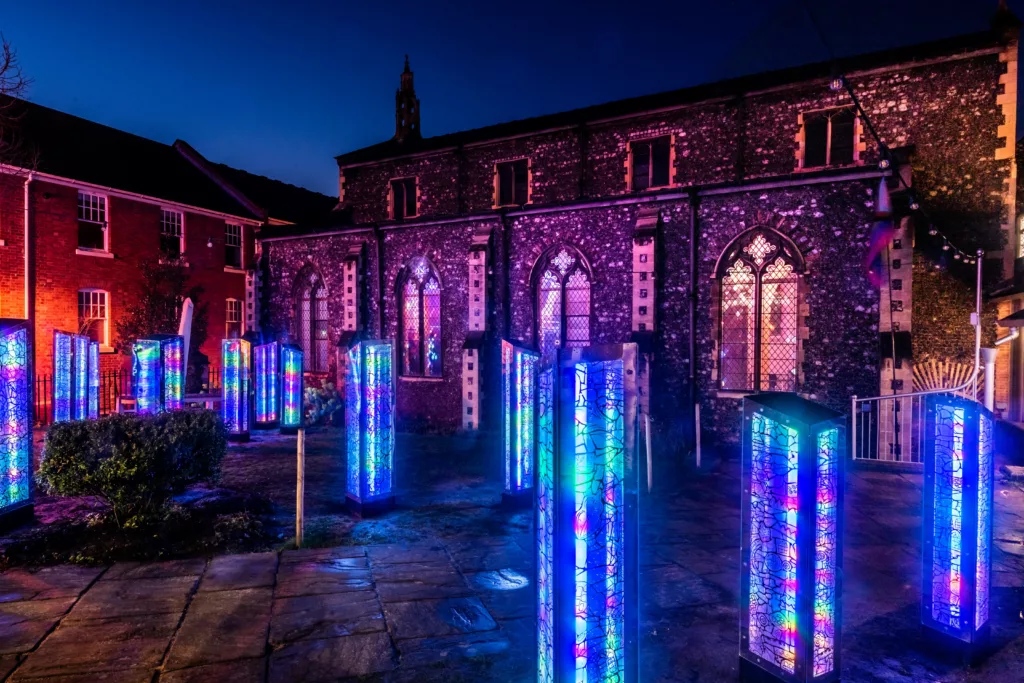
Flint by toyStudio at Norwich Arts Centre
Norfolk’s history is celebrated in the artwork Flint by toyStudio, a series of mirrored totems placed around the grounds of the Norwich Arts Centre. Delivery of Flint was led by Norwich BID. The artwork’s shapes are inspired by the organic forms of the knapped flint walls, seen at the Church of St Swithin located nearby. Norfolk is famous for the naturally occurring flint, often visible across fields and heaths.
During the day, the mirrored surfaces reflect their immediate surroundings, creating a distorted mirror maze for the public to interact with. At night, the lights illuminate, and the mirror surfaces transform into a collection of seemingly endless infinity mirrors. The visible patterns have been derived through workshops exploring local features with members of the community and interpreted by Norwich-based illustrator Ellen Harling.
Flint has been created by artist Toby Plunkett, working with art collective toyStudio, who has previously designed work that has been installed in Canary Wharf, Sloane Square London and Arizona, USA.
Norwich Arts Centre is a live music venue, theatre and art gallery and a key part of Norwich’s cultural community, making it the perfect host for this artwork. St Benedicts Street is steeped in rich cultural heritage – with independent boutiques, galleries, churches and eateries there is plenty in the area to satisfy the senses.
The other artworks which form the Norfolk Way Art Trail are Flock at Diss Mere, Iron Reef at Reedham Ferry Inn, Honing Passage at Honing Station and Interval at Eastbourne Place in Norwich.
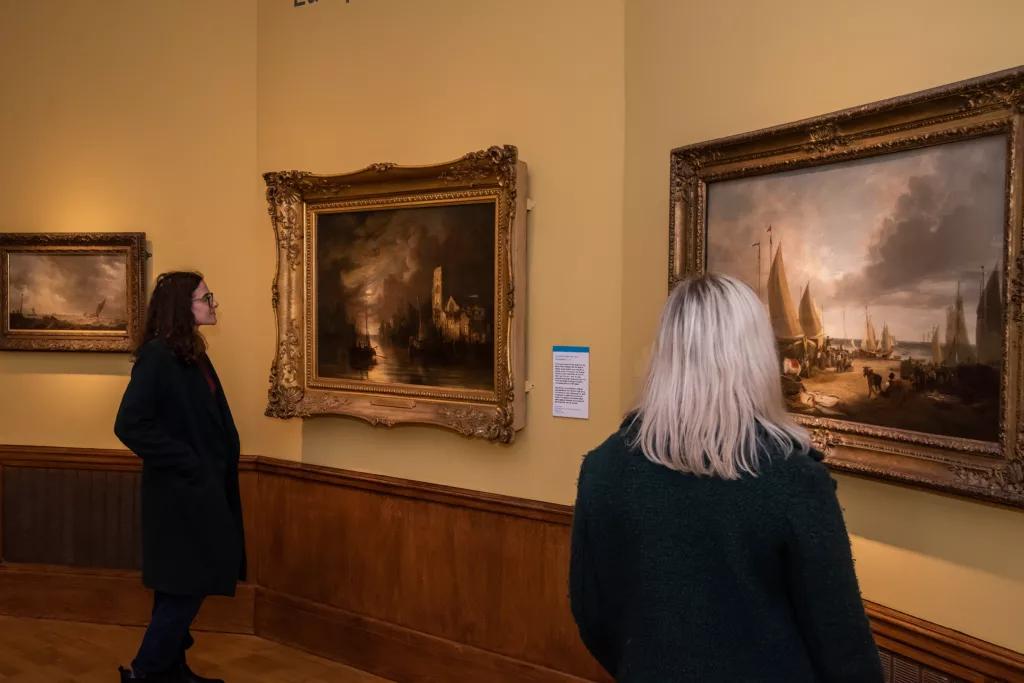
Norwich School of Artists
Norwich Castle may well have the grandeur and imposing architecture of a medieval fortress, but inside these robust walls is a gentler artistic side. Walk into the interior and you will find much more than display cases full of Norfolk history. Wander to one of the five art galleries and you can immerse yourself in visual vista by some of the world’s great artists. Although, perhaps ‘while in Rome’ opt for the Colman or East Anglian Painters Galleries. Here you find, like the names suggest, local artists who painted the Norfolk landscape generations ago. The Colman Gallery has a selection of the Norwich School of Artists, in fact it’s home to the world’s largest collection of works by artists of the Norwich School, a collective of three generations. This includes John Crome, or ‘Old Crome’ as he was known, and John Sell Cotman. The Norwich Society of Artists was founded in 1803 by John Crome and Robert Ladbrooke as a club for locals who could discuss ideas and concepts. The club’s aims were “an enquiry into the rise, progress and present state of painting, architecture, and sculpture, with a view to point out the best methods of study to attain the greater perfection in these arts.” As with many a club, the best meeting place is the local pub, and these creative artists were no exception. The society’s first meeting was in “The Hole in the Wall” tavern. Crome and Cotman are most well-known, but the club attracted quite a few local male artists. However, hidden in the who’s who of Norfolk painters there is also a single female hand, and what an artistic hand it was. Eloise Harriet Stannard (1829–1915) was a British 19th century painter known for her still life work. She was one of only two notable women artists associated with the Norwich School of painters, Britain’s first provincial art movement.
Eloise Harriet Stannard was born in Norwich, she was one of fourteen children of landscape painter and drawing teacher Alfred Stannard and Martha Stannard. Her uncle was the painter Joseph Stannard; both her father and her uncle were members of the Norwich School of painters, Britain’s first provincial art movement. Eloise and her aunt Emily Coppin Stannard (Joseph’s wife) would become the only two notable women artists associated with the Norwich School.
Her choice of subjects was mainly fruits—particularly foreign fruits, which were arranged in various baskets and bowls painted a monochrome background using natural light. Look carefully and you might just find small insects clambering over the fruit. Famous for her fine brushwork and multi layers of paint she created a characteristically luminous surface. Stannard is today considered one of Britain’s most gifted still life painters. Clearly her paintings have both taste and beauty.

For the Love of Butterflies
Free spirited Victorian adventurer Margaret Fountaine gave an extraordinary legacy to the Castle Museum in Norwich. On her death in 1940, cabinets of more than 22,000 butterflies were donated to the Museum but the astounding collection came with a condition. The Museum must also accept a sealed black metal box which could not be opened until 15th April 1978. When the box was at last unlocked, inside were twelve thick diaries of over a million words, photographs, pressed flowers, postcards and letters full of colourful detail about Margaret’s travels across the globe. She took her butterfly net to sixty countries during fifty years of questing for rare species, often travelling by bicycle, the trusty transport of early female liberation. Begun on her 16th birthday, her diary was kept faithfully until her death, reputedly of a heart attack on a mountain path near Port of Spain in Trinidad, butterfly net in hand.
Her candid memoir records the unconventional life and loves of an independent-minded woman, a pioneer of citizen science. From Turkey to Tibet, Syria to South Africa, she roamed the world often with a male companion, Khalil Neimy, who was 15 years younger than Margaret, and married but not to her. Romantic and courageous, she lived on her own terms, acknowledged by Rosie’s Plaques, a guerrilla art project celebrating the radical women of Norfolk. A permanent double case in the Castle Museum’s Natural History gallery displays her lifelong work.

Maids Head Hotel: The Oldest in the Country
Maids Head Hotel in Norwich’s historic Tombland recently had a multi-million pound make-over with guests at the heart of every decision. A site of hospitality for over 800 years, it has a good claim for being the UK’s oldest hotel.
From a Bishop’s grand Norman palace to a notorious 13th century tavern, these walls echo with amazing stories. Edward the Black Prince feasted here after a jousting contest and years later, Catherine of Aragon, Henry VIII’s first wife came to party, perhaps in the 16th century ‘snug’. Renowned as a clean lodgings the Maids Head was noted as a safe place to stay during 17th century plague outbreaks. By the 18th century it was a bustling coaching inn where local radicals cheered seismic uprisings, in 1789 drinking the health of rebellious Thomas Paine and revolutions in France and America. Americans with more frivolous activities in mind met sweethearts here in WW2, before heading over the road to the Samson and Hercules dance hall. Never a dull moment!
Now an elegant city hotel, Maids Head blends modern comfort with magnificent heritage. The Wine Press Restaurant was once the 15th century inn courtyard and, believed to be of the same era, the fabulous wood-panelled Oak Room is delightful for afternoon tea.
Want more? How about a spin round the Fine City in a vintage Bentley or booking a Bobbin Bike to explore on two wheels before a night of fine dining? Just ask and the Maids Head will make it happen!

Love Food Walking Tours
Walk the streets of historic Norwich with an expert food guide, taste and drink the culinary diversity present in this impressive historic but vibrant city. Explore its history and drink in its atmosphere, amble through the biggest open-air market in the country with dozens of local produce food stalls. Norwich is also home the best darn’ mustard in the world and has over five hundred restaurants, cafes and bars. Nestled between medieval churches, cobbled streets, a bustling high street, and the winding River Wensum are hundreds of independent food places, with dozens serving locally sourced foods. Your guide Zena is a professional chef, food writer, blogger & cookery tutor at Lodge Farm Kitchen. She has huge passion for all things food and a great knowledge about the City’s food scene, with a tad of interesting facts thrown in. Norwich has much to offer with delicious local flavours fabulous independent restaurants, shots of local ale, a mini cone of fish n chips, a sweet treat or two, tea or coffee. There are different options available all bring out different aspects of Norwich’s food and drink scene. Find out about Norfolk local cheeses, ales, and wines as well as foods from around the world. The real difficulty is which one do you choose?
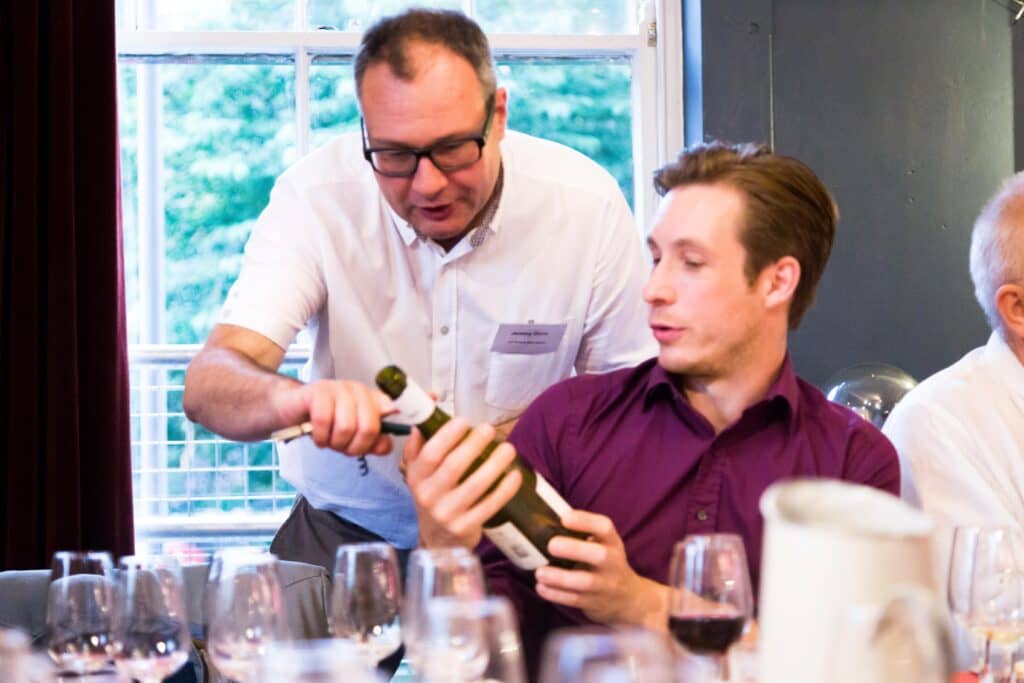
Wine Tasting
Popping corks, laughter, glasses clinking in friendship. Wine is woven through our celebrations from romantic autumn picnics to fabulous festive feasts. But why do wines taste so deliciously different? And how do you choose what to try?
Norwich Wine School is independently owned and proud to work with local suppliers.They host regular wine tastings, courses and food and wine experiences in Norfolk, ideal if you enjoy wine and want to learn more. All events are run by friendly wine tutors and are relaxed and informal with an emphasis on learning by tasting. The best way!Whether you’re new to wine, want to explore different countries or grape varieties, or simply want to enjoy good times in good company, there’s a tasting you.
Try the indulgent ‘Saturday Course’, a full day flagship food and wine experience. Ease into the morning with a glass of English Fizz and breakfast canapés and later, tuck into a delicious 3-course seasonal lunch. You’ll taste at least 15 wines, from all around the world, learn what makes them sing and find out how to make amazing food and wine pairings.‘Themed Food and Wine Evenings’ explore local wines matched with the world’s most famous cuisines. And informal ‘Food & Wine Workshops’ explain why wines can work well with some foods yet not others. Norfolk Wine School is excited about the future for wines made from grapes grown in Norfolk, supporting local vineyards by showcasing their wines and training the next generation of winemakers. Cheers!

Norwich Book Benches
Enjoy the ‘City of Stories’ Book Benches – 8 book shaped benches in key locations in Norwich city centre.
Acting as both functional street furniture as well as stunning public art, the 8 installations are each unique and beautiful. The benches compliment and capitalise on the Norwich’s status of Unesco ‘City of Literature’ and Norwich “The City of Stories” brand (Shortlist City Nation Place Award). They provide opportunities for you to follow a new, free, and walkable city trail, available throughout the year, and encourages visitors to explore new areas of the city while offering unique photo opportunities and opportunity to learn more about the city.
Each bench either illustrates a local piece of literature with connections to the region, a story to compliment the location the benches are situated (past or present) and/or is themed more generally around literature and the printing industry.
Find out more here.
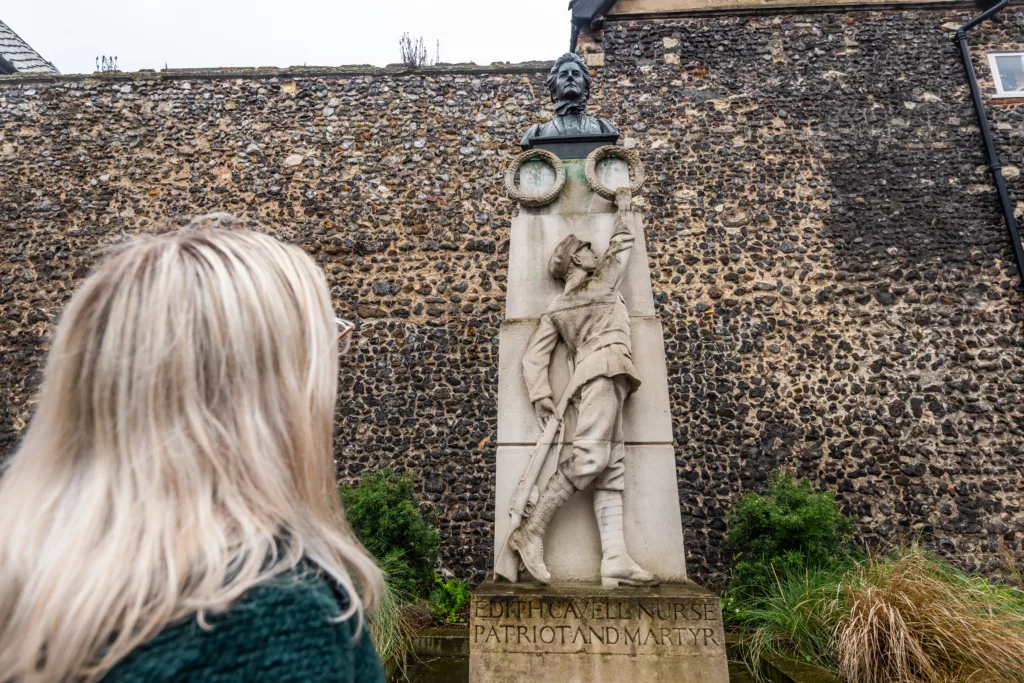
Edith Cavell, a Norwich Heroine
Outside Norwich Cathedral’s arched entrance is a memorial to one of Britain’s bravest women. The likeness of Edith Cavell, in her nursing uniform, gazes over Tombland while a soldier, carved in relief, reaches up to hang a laurel garland honouring her extraordinary courage.
Born in 1865 and raised in the Norfolk village of Swardeston, Edith registered at The London Hospital School of Nursing in 1896. After qualifying she worked at various infirmaries, before starting the first professional school of nursing in Brussels in 1907. When the First World War broke out in 1914, Edith nursed soldiers from both sides of the conflict. Meanwhile, she joined the Belgian Resistance, sheltering well over 200 Allied soldiers, helping them escape into neutral Holland. But Edith was betrayed. She was arrested on 5th August 1915, court-martialled and sentenced to death by firing squad. Ignoring the international outcry, Edith Cavell was shot at dawn on the 12th of October 2015. Her last words were: ‘Standing as I do in view of God and eternity, I realise that patriotism is not enough. I must have no hatred or bitterness for anyone.’
After the war her body was brought home to be given state funeral at Westminster Abbey, followed by a burial at Norwich Cathedral. In the east side of the grounds, a graveside service is held in her memory every 12th October. If you go, afterwards raise a glass to this remarkable daughter of Norfolk in the Tombland pub that bears her name.
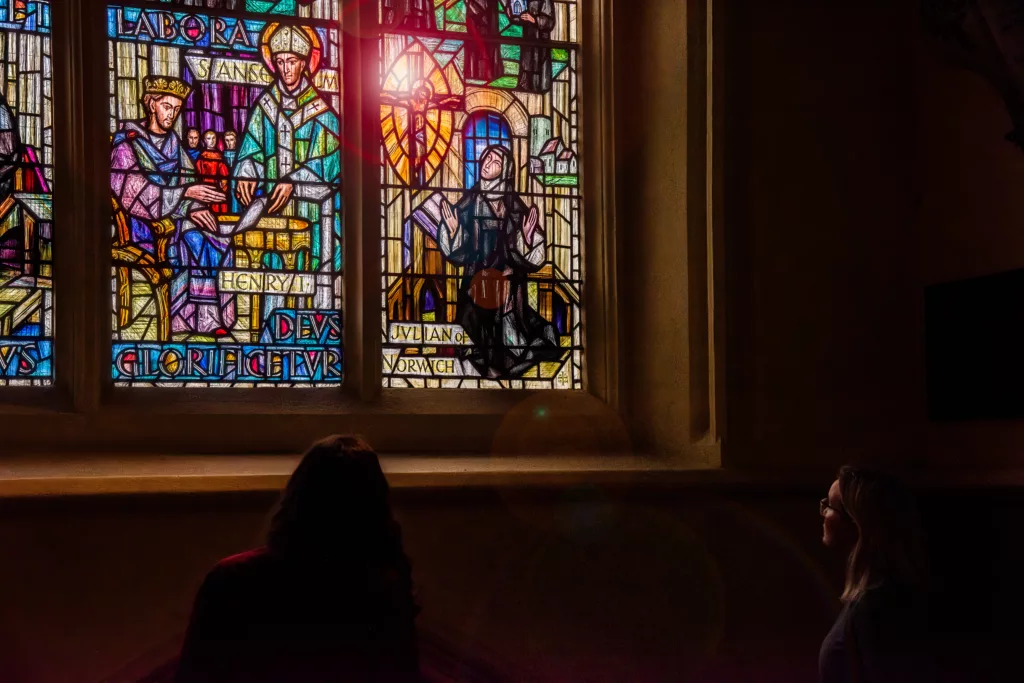
Julian of Norwich
Julian of Norwich certainly understood social distancing. A compassionate medieval mystic born around 1342, she’s the author of the first surviving book written by a woman in English. Revelations of Divine Love is a unique blend of orthodoxy and innovation, including passionate descriptions of her visions of the crucified Christ. Contrary to religious doctrine of the time she wrote that God should be seen as all-loving, rather than all-powerful. Pretty revolutionary in a world controlled by patriarchal domination.
Mentioned as a spiritual counsellor in the The Book of Margery Kempe, it’s through her own writing we know the woman known as Julian of Norwich. We’re not even sure if Julian was her given name, or one she took from the church of St Julian in Norwich. One of the oldest churches in the city, it’s here she lived in solitude for 40 years as an Anchoress, remaining in a cell adjoining the church. Prudent, as during her lifetime the country was devastated by contagious waves of the Black Death. In modern Covid times, her calm optimism exhorts us to keep the faith that ‘All shall be well and all shall be well, all manner of thing shall be well’.
Although Julian’s cell was destroyed in the Reformation, a chapel is built on the original foundations. Walk along the River Wensum to Cathedral Close. At the West Porch of Norwich Cathedral you’ll find a contemporary statue of Mother Julian by sculptor David Holgate, a remarkable woman still watching over Norwich.
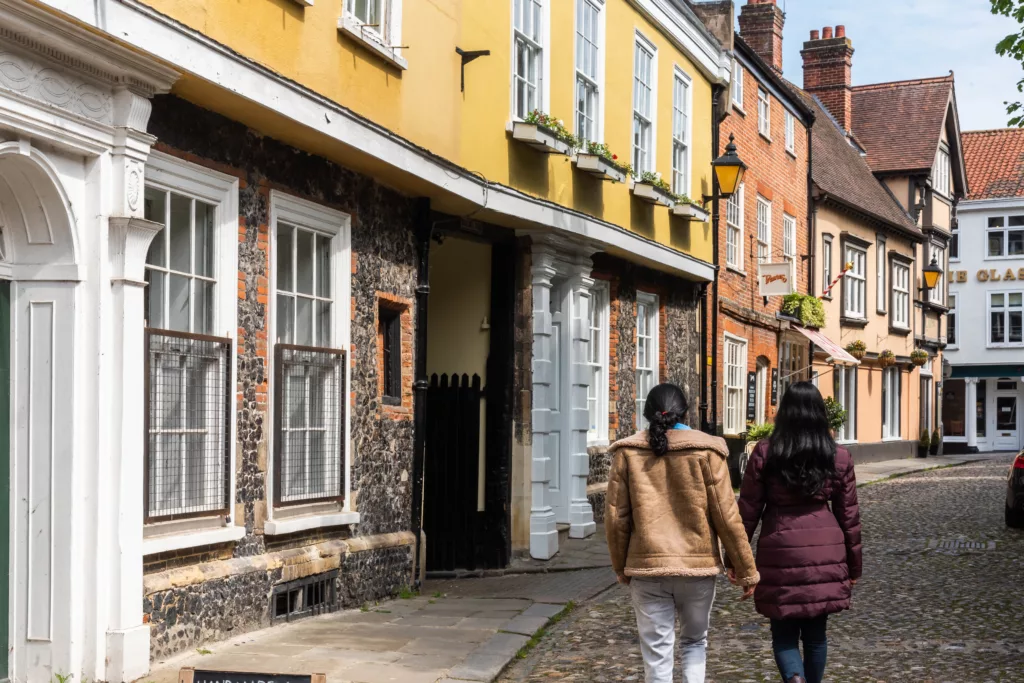
Queenie of Norwich
The Norwich Yards were known for their smell. A rat-infested labyrinth of over 650 courtyards and narrow alleyways, the poorly built dwellings were thrown up in the 1800s, crammed in behind ancient buildings fronting the street. With no sewers or running water, life was hard and people were desperate. Desperate enough to sell their children.
Ellen Hardy was born in 1900 in Queen Caroline’s Yard off Oak Street, youngest of nine. When she was six her mother sold her to a travelling fair. Cocky and resilient, she learned to look after herself. When her fairground family died, Nell, as she was now known, returned to care for her mother. Local crime kingpin Barney Read hired her to speed round the city on a bike, collecting debts from his illegal gambling racket. When the law caught up with Barney, lively Nell got away. The Norwich Evening News headlines read ‘Police Raid on Betting Shop but Queen Bee Escapes.’ And from that day Nell was known as Queenie.
Queenie was never caught and there were more adventures to come. Intrigued? Visit a local bookshop and pick up Queenie of Norwich, entertainingly written by her great-granddaughter LK Wilde.
The slum Yards are mostly gone now, but see if you can find Whip and Nag Yard (Duke Street, NR3 1DL) and Wright’s Court (Elm Hill, NR3 1HQ). ‘After all, it’s not where you start that’s important, but where you end up,’ said Queenie, and she should know!

Mousehold Heath: Remembrance and Rebellion Oak of Remembrance
Take an excursion North-east of the medieval city boundary of Norwich, and you might just come across Mousehold Heath, now sadly much smaller than its once extensive size, but still worth a visit even just for the views of Norwich nestled below. The heath was once kept clear of trees by grazing animals. Transformed by enclosure and farming much has been lost but the remnants of heath can still be found for those who search. Mousehold Heath is designated Local Nature Reserve and a County Wildlife site so look carefully as there are several scarce species living on the site, some of which will surprise you.
Not surprising there are many historical events that have taken place on the heath. Perhaps one of the most unsavoury dates to 1144 when false story that was circulated that a young apprentice boy named William was killed as part of a ritual murder by Jews. The local Sheriff was successful in protecting the innocent Jews from persecution by an angry mob, sadly another example of how rumours, lies and hatred can surface amongst neighbours. It is the first case of what was to become known as ‘blood libel’. The boy later attained the status of saint and martyr and a chapel built there to remember this lost child. Later the chapel was renamed St William in the Wood, although not much remains of the chapel its footprint can still be found on the heath.
Mousehold Heath holds a strategic position overlooking Norwich, so its not surprising that it’s had its share of military occupation. In 1381 during the Peasants’ Revolt a large meeting on the heath took place. On the 17 June local man Geoffrey Litster, was proclaimed “King of the Commons”. Although this was to be short lived as the rebellion was quashed at the Battle of North Walsham between the 25th & 26th June 1381.
In 1549 another rebellion began on 12 July 1549, during a period that became known as the ‘commotion time’. This was led by local landowner Robert Kett and his brother. It began as a protest about enclosures but soon turned into a full-scale insurgency, culminating in the capture of the city of Norwich. The rebels held control of the city for over a month, basing themselves at a camp on Mousehold Heath. Although their petitions for more acceptable treatment failed. After resisting one attempt to remove them, they were finally defeated by John Dudley, Earl of Warwick. Robert and William Kett were seized and taken to London, where they were condemned to death for treason. On 7 December 1549 Robert was executed at Norwich, and his body was hanged on the top of the castle, while that of William was hanged on the church tower at Wymondham. The Kett family line still survives to this day.

Amelia Opie: Radical Novelist, Poet and Philanthropist
Just off Castle Meadow on 22 Opie Street in Norwich there is a plaque celebrating Amelia Opie. You can see her statue above street level, a vivacious, free-thinking woman who published novels, wrote poetry, and fought the horrors of the slave trade.
Amelia was born in 1769, only daughter of James Alderson, a physician with links to the Norwich reform movement. Living in London she associated with radical political circles alongside Mary Wollstonecraft and William Godwin whose daughter, Mary Shelley, wrote ‘Frankenstein’.
In 1798 she married artist John Opie who encouraged her novel and poetry writing. Her most famous book is ‘Adeline Mowbray’ (1804) the story of an unconventional woman clashing with society’s expectations. Many of the heroine’s experiences are based on those of Mary Wollstonecraft.
After John’s death in 1807 Amelia returned to Norwich, renewing her friendship with the Gurneys, a prominent Quaker family. She dedicated the rest of her life to philanthropic projects, visiting workhouses, hospitals and prisons and promoting a refuge for reformed prostitutes. She worked with Anna Gurney to establish the Norwich Ladies’ Anti-Slavery Society and was one of the few women to attend 1840’s World’s Anti-Slavery Convention. Earnest and driven, by all accounts she was also a merry soul who in old age raced a friend in her wheelchair at the 1851 Great Exhibition.
She died in 1853 and is buried in Gildencroft Quaker Cemetery in Chatham Street, one of the ‘profane and opinionated’ Quaker women remembered by Rosie’s Plaques.
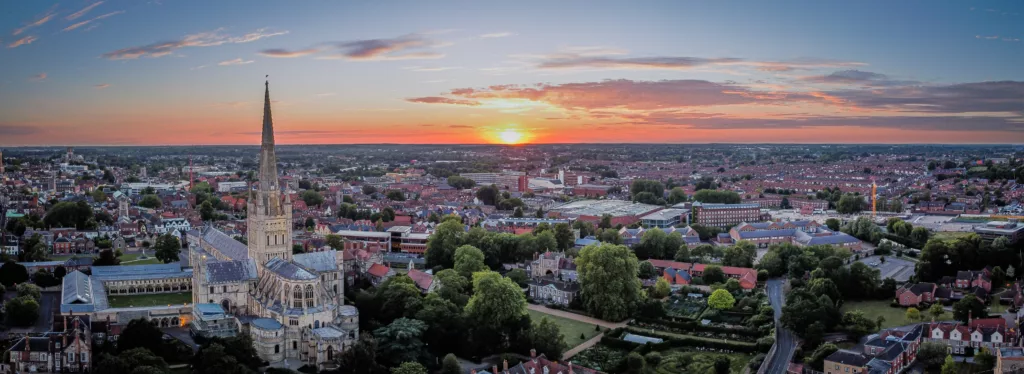
Elizabeth Fry – Norfolk’s ‘Angel of Prisons’
When Elizabeth Fry visited Newgate Prison in 1813 it changed her life. And as a result she changed the lives of countless others.
What she saw at Newgate was harrowing. Over 300 women were crammed together, many with children. Those convicted of murder were jammed in with people who’d stolen a loaf from the market, alongside women who hadn’t yet gone to trial. Conditions were filthy, freezing and violent. So Elizabeth, Quaker minister and mother of 11, set to work.
Elizabeth Gurney was born in 1780 in Gurney Court, Magdalen Street, Norwich, where a plaque commemorates her, and also at the Friends’ Meeting House in Goat Lane. Also, the UEA’s School of Social Work and Psychology is housed in the Elizabeth Fry building. Daughter of influential Quakers, aged 20 ‘Betsy’ married Joseph Fry, cousin of the Fry confectionery family, also Quakers. She was hugely inspired by the travelling Quaker speaker William Savery, and committed her life to good works. After her Newgate experience she campaigned tirelessly for prison reform including segregation of the sexes, female matrons for female prisoners, education and employment. Called the ‘Angel of Prisons’, she cared about rehabilitation over punishment.
Her drive for change played a huge part in transforming prison ships, the abolition of slavery, housing for the poor, soup kitchens and nursing. Elizabeth is one of only three women celebrated on a Bank of England note (£5), pictured reading to women prisoners. Long after her death in 1845, Elizabeth Fry still inspires social transformation today.

Black Anna: Jazz and Jive
In 2019 Norwich and Norfolk CAMRA’s tasting panel selected their top beers of the year from a wide-ranging field of 82 brews. The overall gold winner that year was from Chalk Hill Brewery’s ‘Black Anna’. But this is no random name, this was a real person whose compassion and talent made her a local celebrity. Black Anna was the nickname given to Antoinette Hannent, a Norwich jazz singer of Italian descent and licensee of The Jolly Butchers.
Anna was particularly well loved in the gay community who she always made welcome and showed consideration. Especially in a period of history when homosexuality was still outlawed. The Jolly Butcher’s became the place to be for visiting celebrities and jazz fans keen to hear her unique jazz voice.
Her nickname was possibly a result of her habitual style of dressing – always black, or perhaps her strong personality, she was well known to be a force to be reckoned with. She was born in Norwich in 1905 to a family of Italians who had originally walked from Medina to Norwich. Her mother, Elisabetta, was known as the ‘queen of the organs’, after her love of and skill at playing musical instruments. After a ballroom career Anna married Kenneth Hannent and the two of them took over Ber Street’s Jolly Butchers pub in 1935. The pub was well known for also containing a dosshouse, for rough sleepers and who habitually drank too much. Even though Anna was teetotaller she always supported the dosshouse up until her death in 1976. During the Second World War the pub became known as a cheap place to stay, especially for GI servicemen who also brought with them jazz and blues songs. These well suited Annas strong voice and her singing became legendary and very popular, making the pub the place to be.
Even though Kenneth died not long after the war Anna took over the pub licence, but still found time to entertain her regulars with her charismatic voice, she even went on tour and performed at festivals with some of the greats. She was once asked what she thought about the English jazz scene musicians, she responded by saying: “they’re good but too perfect – no feeling, they don’t miss a note, they’re dead from the neck up.” Although the Jolly Butchers may be no more there is a plaque to find which marks the story of this remarkable woman.

Norwich Beer Tour
Norwich is justly proud of its boozers and legend has it the city has 365 pubs – one for each day of the year. (And 52 churches so if you feel the need, you can repent at a different one every Sunday!) The Fine City’s a fantastic bet for a beer all year round, particularly cosy and welcoming on chilly winter days. With so many excellent pubs, it’s hard to know where to start. Unless, that is, you have an expert guide!
This relaxed walking tour takes you to six celebrated public houses in and around the centre of Norwich, each one known for its warm hospitality and beautifully pulled pints! Your guide is not only super knowledgable about the city’s rich heritage, she’s a trained sommelier who’ll introduce you to the friendly local bar teams. While learning about the fine art of brewing, you’ll sample lip smacking local and specialist beers. Your guide’s always ready with brilliant anecdotes and stories to entertain in classic pub style so you’ll be able to ask questions and enjoy yourself in warm, like-minded company.
It’s possible that accessible public transport might be used to reach destinations a bit further afield. With advance notice, the guide offers tours in BSL and can adapt delivery styles for varied sensory needs. Please allow around four hours for your tour. The cost is £40pp which includes half a pint of delectable local beer or cider at each stop and a tasty light snack.
Build your own itinerary
If you fancy creating your own itinerary for a day trip to Norfolk or a longer visit, it couldn’t be simpler. Just go to Search Activities and select from our wide range of free and paid-for experiences, saving any that capture your imagination with the click of a button.
Once you’ve finished, you’ll find all the information stored in My Favourite, where you can drag and drop activities to create your own day-by-day itinerary! You can download this to a calendar and even share it with friends.
